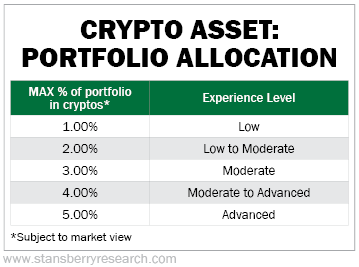Doc's note: Cryptocurreny is one of the biggest investment stories right now. But knowing how to invest in such a speculative asset is confusing.
That's why I'm sharing this essay from Eric Wade, bitcoin expert and editor of Crypto Capital, where he explains how much you should invest in cryptocurrencies.
While U.S. regulators are quietly raging a war on cryptocurrencies... U.S. President Donald Trump is about to help them go mainstream.
"Eric, how much should I invest in cryptos?"
It's one of the most common questions I'm asked about cryptocurrencies.
And I get it. Cryptos are some of the most volatile assets you'll ever see. And with so many different types of cryptos out there, it can be hard to know how much of your portfolio you should allocate to any one of them.
So today, I'm clearing up the confusion...
Start small.
The first thing to keep in mind when you're investing in cryptos is to start small. And when I say small, I mean with a few hundred bucks. (Remember that you can buy a fraction of a bitcoin... the minimum lot size is not one bitcoin.)
Using a small sum, get used to the process of transferring, trading and safely storing cryptos. Once you're comfortable, then you can start to "level up" to bigger sizes.
You see, the process of buying, moving and storing cryptos is not like traditional online banking or investing. In the world of crypto, if you make a mistake you can lose your money in an instant. If you send bitcoin to the wrong address, it's gone. That's it. There's no recourse. And there are very few, if any, "I forgot my password" options in the crypto world. So it's critical to familiarize yourself with the mechanics of buying crypto and moving it around first with a relatively small sum, before moving on to larger dollar amounts.
Never invest more than you can afford to lose.
By that I mean, if you woke up tomorrow and your entire crypto portfolio was worthless, you'd be fine financially. It would sting of course, but it wouldn't be ruinous or anywhere close. So be conservative.
The table below is a very general portfolio allocation guide...
Now, before I get a slew of angry emails, let me point out that the left-hand column denotes the MAXIMUM PERCENTAGE of a portfolio that should be invested in cryptos depending on your experience AND your market bullishness.
Even the most enthusiastic beginner who's in the process of learning the ropes should not allocate a position that exceeds 1% of their total investment portfolio to begin with... at an absolute maximum. If your portfolio grows to exceed your maximum allocation, that's fine – but I'm talking about the hard dollars you initially commit to crypto. AND remember, never invest more than you can afford to lose.
So how much do you allocate amongst different cryptos?
There's bitcoin, and then there's everything else.
In my opinion, bitcoin should be the largest single position of any crypto portfolio.
You see, bitcoin is still the "reserve" currency of all cryptocurrencies. So it makes sense to understand bitcoin first.
Let me share an example.
You might have heard about Ethereum. It's a virtual currency network that's been in the press a lot. It has a wave of blue-chip IT and financial companies (including JP Morgan and Microsoft) using it for blockchain-related opportunities.
Ethereum soared over 3,500% in the six months leading up to June 2017.
But if you wanted to buy Ethereum, many exchanges require you to buy bitcoin first... then trade that bitcoin for Ethereum.
That's why you should take out the time to figure out bitcoin.
It's the global crypto reserve currency. And it's the first crypto asset that tens of millions of people who enter the space after you will be buying.
So you should buy it before them.
If you are looking to become an active crypto investor, I think you should hold anywhere from 30% to 70% of your crypto portfolio in bitcoin, with other crypto assets taking up the rest.
And note: The newer you are to the space, the higher the percentage of bitcoin you should own.
Total beginners will start by allocating 100% into bitcoin as that's the first crypto they buy. Then they'll get more comfortable and start to buy other cryptos.
So the proportion of bitcoin will fall below 100% as you begin to diversify. Over time, your portfolio will change in size and bitcoin as a proportion of your portfolio may further decline: but don't forget that bitcoin is the "bedrock" of any crypto portfolio. So anyone just starting out should be predominantly long bitcoin.
And please remember: Do not allocate more personal capital to this sector than you can afford to lose. This is as speculative and risky as it gets... that's the price we pay for the kind of returns on offer.
Take a look at your crypto portfolio and ask yourself if you could stomach a 50% (at a minimum) decline tomorrow without spinning into a panic. If the answer is no, then you need to do something about it.
And if you don't already own crypto, now is the time to start buying.
Good investing,
Eric Wade
Editor's note: Eric believes a major event on September 12 could cause one tiny crypto to soar five, 10, or even 50 times over the long run. He just put together a special presentation with all the details. Watch it right here.


